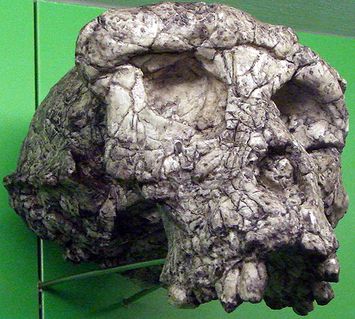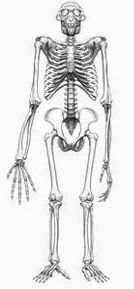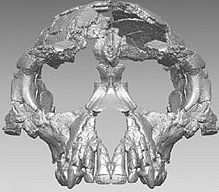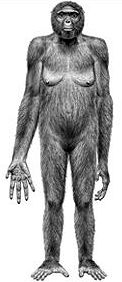Very Early Hominids
The so-called "hominids," most importantly including the two genera Australopithecus and Homo, are a family of the hominoid superfamily (table), having split off from the branch leading to modern apes, probably sometime between 7 mya (million years ago) and 6 mya.
(An alternative classification regards the category "hominids" as including Australopithecus and humans in a subgroup called "hominins" or "hominines," plus chimps and gorillas. As a cover term for Australopithecus and homo, some authors and editors therefore say "hominin" when others say "hominid.")
Our knowledge of the earliest hominids is still very fragmentary. This page provides a brief summary of a few of the earliest known hominid forms.
Sahelanthropus tchadensis

- Most Famous Specimens:
- Toumaï
- Location:
- Chad
- Time Range:
- Approximately 7-6 mya.
- Cranial Capacity:
- 350 cc.
- Cranial Features:
- The skull shape similar to that of modern chimpanzees, but the foramen magnum is located on the bottom of the skull and points downward, suggesting bipedalism.
- Special Note:
- This badly shattered skull was found in Chad, about 2500 km west of the fecund fossil beds of eastern Africa. This has led to a rethinking of the range of early hominids, previously known only from the eastern and southern parts of the continent.
- Although currently classified as a hominid, this skull almost looks like what one might expect at the dividing point between the hominid and modern ape descent lines. Initially some scholars argued that proper classification might depend on whether it was male —if so the small face and teeth would suggest it was a hominid— or female —in which case less credence could be placed in that generalization, and it might be a small member of some proto-ape line.
- Wikipedia link
Return to top.
Orrorin tugenensis
- Most Famous Specimens:
- "Millenium Man"
- Location:
- Kenya
- Most Famous Sites:
- Tugan Hills
- Time Range:
- Approximately 6.2-5.6 mya.
- Special Note:
- Specimens found so far include teeth and limb bones, but the ball-joint at the top of the femur suggests bipedal locomotion. If so, it temporarily holds the status of the second oldest hominid we know about of which that can be said.
- Wikipedia link
Return to top.
Ardipithecus ramidus
- Most Famous Specimens:
- "Ardi"
- Location:
- Ethiopia
- Most Famous Sites:
- Middle Awash Valley (about 230km northeast of Addis Ababa)
- Time Range:
- Approximately 4.6-4.4 mya.
- Cranial Capacity:
- 300-350 cc.
- Cranial Features:
 Strongly projecting face; canine teeth relatively small and not honed (sharpened) against premolars when the jaw is closed; teeth are compatible with omnivorous but largely frungivorous (fruit-eating) diet.
Strongly projecting face; canine teeth relatively small and not honed (sharpened) against premolars when the jaw is closed; teeth are compatible with omnivorous but largely frungivorous (fruit-eating) diet.- Postcranial Features:
- Opposable large toe (associated with arboreality) but flexible hand; canine teeth midway in size between modern humans and modern chimps; pelvis similar to later Australopithecus afarensis.
- Habitats:
- Woodland
- Special Note:
 If one assumes that the last common ancestor (often abbreviated LCA) of modern apes and modern people should look chimp-like, Ardipithecus seems to prove that wrong, since these forms are in many ways much less chimp-like than modern chimps. That is hardly surprising, since one ought to expect that ancestors of modern apes have been evolving over the millenia just as ancestors of modern humans have. Still, it surprised people. Modern chimps and gorillas engage in knuckle-walking (KW), for example, while early hominid forms show no sign of it.
If one assumes that the last common ancestor (often abbreviated LCA) of modern apes and modern people should look chimp-like, Ardipithecus seems to prove that wrong, since these forms are in many ways much less chimp-like than modern chimps. That is hardly surprising, since one ought to expect that ancestors of modern apes have been evolving over the millenia just as ancestors of modern humans have. Still, it surprised people. Modern chimps and gorillas engage in knuckle-walking (KW), for example, while early hominid forms show no sign of it.- Pictures here are from the public release by the journal Science, published by the American Association for the Advancement of Science. For a link to the full Science coverage, click here.
- Wikipedia link
- Smithsonian link
Return to top.
Ardipithecus kaddaba
- Location:
- 5 sites in Ethiopia
- Time Range:
- Approximately 5.8-5.2 mya.
- Postcranial Features:
- A toe bone appears to provide evidence for full bipedality.
- Special Note:
- Although earlier than Ardipithecus ramidus, the two forms are remarkably similar, so far as one can tell from their fragmentary remains, and should arguably be classified into the same species.
- Wikipedia link
- Smithsonian link
Return to top.
Australopithecus anamensis
- Location:
- Kenya, Ethiopia
- Time Range:
- Approximately 4 mya.
- Special Note:
- At this time the smart money seems to see this form as ancestral to Australopithecus afarensis, or very similar to what an Au. afarensis ancestor would be like.
- Wikipedia link
Return to top.
Australopithecus bahrelghazali
- Most Famous Sites:
- Koro Toro, Chad
- Time Range:
- Approximately 3.6 to 3.0 mya.
- Habitats:
- Savannah
- Special Note:
- Only one specimen is known, made up of two teeth plus a jaw containing 7 teeth. 2012 analysis suggests a diet of underground parts of sedges and grasses from a savannah environment. This would be unusual for an early hominid.
- Wikipedia link
Return to top.



 Strongly projecting face; canine teeth relatively small and not honed (sharpened) against premolars when the jaw is closed; teeth are compatible with omnivorous but largely frungivorous (fruit-eating) diet.
Strongly projecting face; canine teeth relatively small and not honed (sharpened) against premolars when the jaw is closed; teeth are compatible with omnivorous but largely frungivorous (fruit-eating) diet. If one assumes that the last common ancestor (often abbreviated LCA) of modern apes and modern people should look chimp-like, Ardipithecus seems to prove that wrong, since these forms are in many ways much less chimp-like than modern chimps. That is hardly surprising, since one ought to expect that ancestors of modern apes have been evolving over the millenia just as ancestors of modern humans have. Still, it surprised people. Modern chimps and gorillas engage in knuckle-walking (KW), for example, while early hominid forms show no sign of it.
If one assumes that the last common ancestor (often abbreviated LCA) of modern apes and modern people should look chimp-like, Ardipithecus seems to prove that wrong, since these forms are in many ways much less chimp-like than modern chimps. That is hardly surprising, since one ought to expect that ancestors of modern apes have been evolving over the millenia just as ancestors of modern humans have. Still, it surprised people. Modern chimps and gorillas engage in knuckle-walking (KW), for example, while early hominid forms show no sign of it.